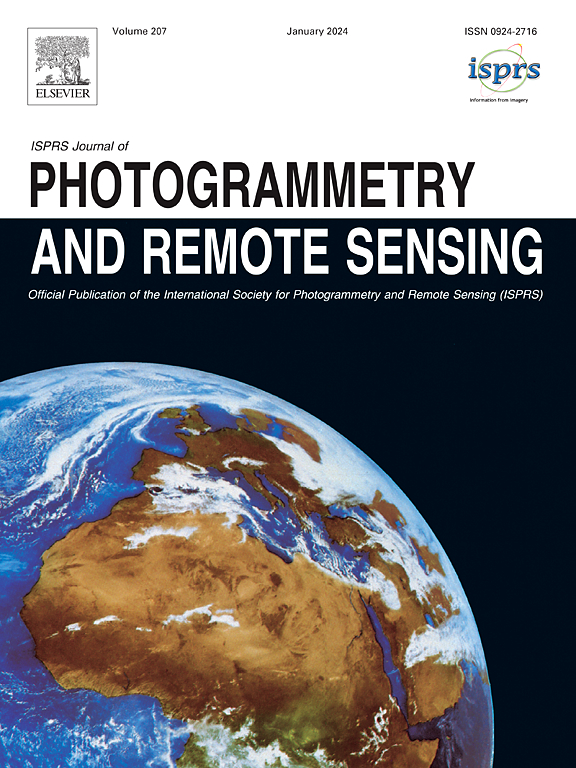SDCluster:一种基于聚类的遥感图像语义分割自监督预训练方法
IF 12.2
1区 地球科学
Q1 GEOGRAPHY, PHYSICAL
ISPRS Journal of Photogrammetry and Remote Sensing
Pub Date : 2025-03-07
DOI:10.1016/j.isprsjprs.2025.02.021
引用次数: 0
摘要
减少遥感语义分割模型对标记训练数据的依赖是实际模型部署的关键。自我监督预训练方法通过设计借口任务从未标记数据中学习表示,提供了解决这一需求的方法。目前基于学习的自监督方法和基于掩膜图像建模的自监督方法的一个缺点是,如果没有对语义分割任务进行微调,则难以评估预训练模型的质量。因此,本文提出了一种基于像素级聚类的自监督学习方法SDCluster,该方法可以通过可视化聚类结果对预训练模型进行定性评估。具体来说,SDCluster通过加入聚类分配模块将自蒸馏框架扩展到像素级。然后,设计了聚类约束模块,包括原型约束模块和语义一致性约束模块,以消除无效的聚类原型并保留地物的语义信息;得益于像素级聚类和逐像素分类语义分割之间的相关性,实验结果表明,与流行的自监督方法相比,SDCluster具有具有竞争力的微调精度和鲁棒的少帧分割能力。大规模的预训练实验和实际应用实验也证明了该方法的泛化能力和可扩展性。代码和实际应用实验数据集可在https://github.com/openrsgis/SDCluster上获得。本文章由计算机程序翻译,如有差异,请以英文原文为准。
SDCluster: A clustering based self-supervised pre-training method for semantic segmentation of remote sensing images
Reducing the reliance of remote sensing semantic segmentation models on labeled training data is essential for practical model deployment. Self-supervised pre-training methods, which learn representations from unlabeled data by designing pretext tasks, provide an approach to address this requirement. One inconvenience of the currently contrastive learning-based and masked image modeling-based self-supervised methods is the difficulty in evaluating the quality of the pre-trained model without fine-tuning for semantic segmentation task. Hence, this paper proposes a pixel-level clustering-based self-supervised learning method, named SDCluster, which allows for a qualitative evaluation of the pre-trained model through visualizing the clustering results. Specifically, SDCluster extends the self-distillation framework to the pixel-level by incorporating the clustering assignment module. Then, clustering constraint modules, including prototype constraint module and semantic consistency constraint module, are designed to eliminate ineffective cluster prototypes and preserve the semantic information of ground objects. Benefiting from the correlation between pixel-level clustering and per-pixel classification of semantic segmentation, experimental results indicate that SDCluster exhibits competitive fine-tuning accuracy and robust few-shot segmentation capabilities when compared to prevalent self-supervised methods. Large-scale pre-training experiment and practical application experiment also prove the generalization ability and extensibility of the proposed method. The code and the dataset for practical application experiment are available at https://github.com/openrsgis/SDCluster.
求助全文
通过发布文献求助,成功后即可免费获取论文全文。
去求助
来源期刊

ISPRS Journal of Photogrammetry and Remote Sensing
工程技术-成像科学与照相技术
CiteScore
21.00
自引率
6.30%
发文量
273
审稿时长
40 days
期刊介绍:
The ISPRS Journal of Photogrammetry and Remote Sensing (P&RS) serves as the official journal of the International Society for Photogrammetry and Remote Sensing (ISPRS). It acts as a platform for scientists and professionals worldwide who are involved in various disciplines that utilize photogrammetry, remote sensing, spatial information systems, computer vision, and related fields. The journal aims to facilitate communication and dissemination of advancements in these disciplines, while also acting as a comprehensive source of reference and archive.
P&RS endeavors to publish high-quality, peer-reviewed research papers that are preferably original and have not been published before. These papers can cover scientific/research, technological development, or application/practical aspects. Additionally, the journal welcomes papers that are based on presentations from ISPRS meetings, as long as they are considered significant contributions to the aforementioned fields.
In particular, P&RS encourages the submission of papers that are of broad scientific interest, showcase innovative applications (especially in emerging fields), have an interdisciplinary focus, discuss topics that have received limited attention in P&RS or related journals, or explore new directions in scientific or professional realms. It is preferred that theoretical papers include practical applications, while papers focusing on systems and applications should include a theoretical background.
 求助内容:
求助内容: 应助结果提醒方式:
应助结果提醒方式:


